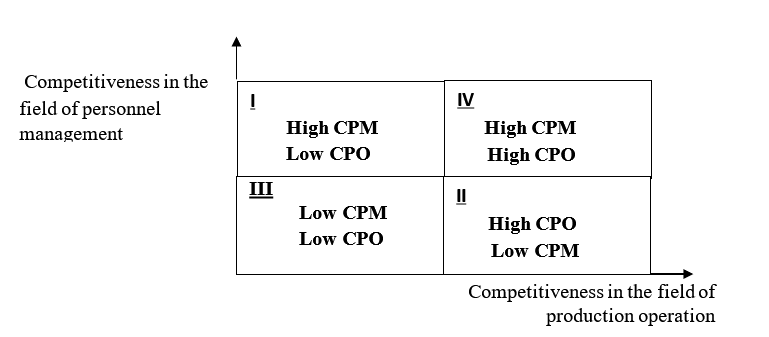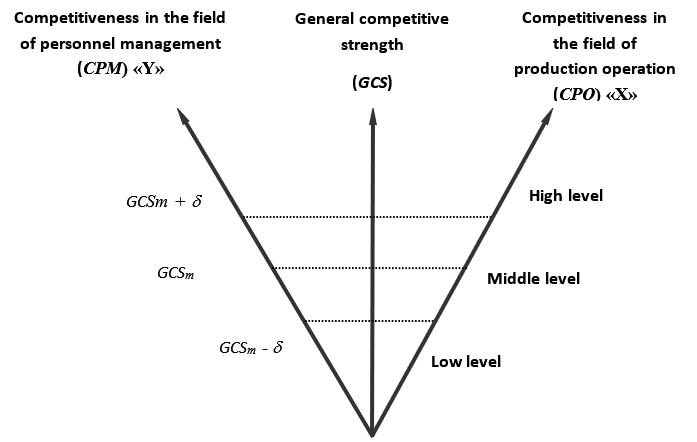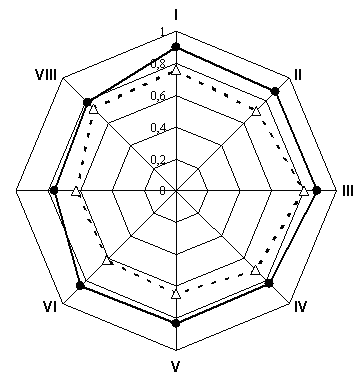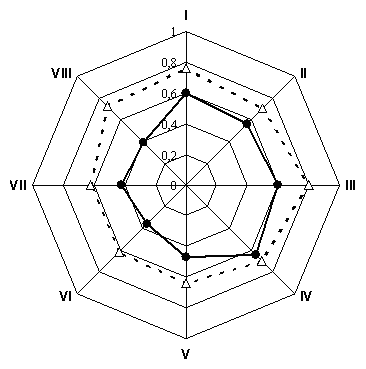Abstract
The article is devoted to the development of a theoretical model and methodology for assessing the competitiveness of managerial personnel. Modern increased requirements for evaluating managers require the development of new integral indicators of managerial performance, which would take into account the specifics of a market economy. Such an integral indicator is the index of a manager’s competitive strength. To this date, there are few studies that attempt to synthesize various properties and characteristics of a manager in the context of the category of competitiveness, as an integral indicator of the whole person. Methodological tools for assessing competitive strength as a set of professional and social competencies have not been developed. The model discussed in this article is based on the systemic interconnection of two directions of manager’s activity - production and people, manifested in general competitiveness, as a synergistic effect. The model distinguishes between two types of competitive power - in the field of production operation (CPO) and in the field of personnel management (CPM). In essence, the two types of competitive power are in a dialectic relationship and determine the general competitive strength (GCS) of a manager, in the form of a synergistic effect. The value of GCS determines the real and future performance of a manager, is an indicator of his potential in the field of production management and personnel management. In practical terms, the model offers a list of competencies that determine CPO and CPM, the pattern and mathematical formula for calculating the GCS index.
Keywords: Assessmentcompetenceindex of general competitive strengthmanager's competitive strengthmodel
Introduction
Modern increased requirements for the assessment of managers and, above all, for its reliability, adequacy and predictability require the development of new integral indicators of managerial performance, which would take into account the specifics of a market economy. In our opinion, such an integral indicator may be an indicator of manager’s competitive strength. In the developed concept of managerial training, competitive strength is considered an important systemic quality of the personnel management process in the market conditions. It is presented as an important integral quality that characterizes the ability of a particular manager to get the best results in various areas of management compared to the best analogues in the competitive market of services. This applies to goal-setting, planning, organization, motivation, innovations, personnel strategy and other activities of the manager.
In the conditions of market relations, the chief executive officer, who aims at ensuring the competitive power of organization, must first meet all modern requirements of competitive strength. The proposed methodology for assessing competitiveness, along with traditional professional competencies, takes into account social competences in the activities of a manager. Such an approach is not always favourably accepted by managers who are accustomed to thinking in technocratic categories that exclude the human factor as important for achieving a result. On the other hand, it is the social competencies for the Russian leader that are the “weak link”; they are the least developed, which means they are untapped opportunities (potential) for further managerial growth. The proposed approach to assessing competitive strength draws attention to the highlighted problem of managerial personnel and offers a possible solution.
Not all competitive features and qualities of a manager are involved simultaneously in the process of a particular professional activity. Many properties cannot manifest themselves for a long time, “doze” and wait for conditions that will require their actualization. The meaning of competitive behavior is that managers, based on an adequate self-assessment of their competitive advantages, can freely, consciously and optimally operate this strategic arsenal to achieve their goals. In this paper competitive strength is understood as: “a socially-oriented system of abilities, qualities and characteristics of a manager: (1) characterizing its potential for achieving success in professional activities; (2) determining adequate individual behavior in dynamically changing conditions; (3) providing inner self-confidence, harmony with oneself and the world around; (4) implying a willingness to take responsibility for their actions” (Shapovalov, 2003).
The theoretical and methodological basis of the study is the classification of concepts of personnel management depending on (1) the social or economic orientation of management activities and (2) focus on accounting for the human factor as a resource of an organization or as a set of personal characteristics of an employee, proposed by Evenko (2011).
Problem Statement
At present, researchers in various fields of science are addressing the problem of manager’s competitive strength. This problem is most fruitfully developed in the theory of management by both foreign (Daft, 2012; Santalainen, Voutilainen, Porenne, & Nissinen, 1993; Ansoff, 1979; McClelland, Koester, & Weinberger, 1990; Parry, 1996; Porter, 2005; Weissmann, 2006; Woodcock & Francis, 1982) and domestic researchers (Zolotareva, 2012; Kara, 2012; Mitina, 2002; Tuktarov, 2006; Fatkhutdinov, 2007; Fomin, 2004; Shapovalov, 2003). Despite the fact that in recent years domestic scientists continue to address this problem (Gorbanev, 2016; Gornastaeva, 2013; Ivanovskaya & Suslova, 2012; Lavrentiev & Krylov, 2015; Shapovalov, 2016), practical issues in the functioning of organizations and enterprises show that the problem of managerial competitiveness requires further study.
To date, there have been many attempts to study the various properties and characteristics of manager’s competitive strength. However, there are few works in which an attempt is made to synthesize these characteristics in the context of the category of competitiveness, as an integral concept of the manager’s holistic personality. Methodological tools for assessing competitive strength as a set of professional and social competencies have not been developed. As a rule, the center of gravity shifts to primarily industrial technocratic competencies as the basis for achieving production efficiency.
The proposed improvement of the competitiveness of management personnel based on its objective assessment is certainly relevant. In the difficult conditions of Russia's socio-economic development, the manager becomes the decisive factor in the effective functioning of the organization, and this must be taken into account in the strategic management policy.
Research Questions
3.1. Identify the typology of competitive manager.
3.2. Build a model and a pattern for calculating the competitive strength of the manager.
3.3. Select the competencies that determine the competitiveness of a manager in the field of production and personnel management;
3.4. Practically implement the developed theoretical approach to assessing the competitiveness of managerial personnel.
Purpose of the Study
4.1. The definition of a theoretical model of manager’s competitive strength.
4.2. Develop a methodology for assessing competitive strength as a major factor in the effectiveness of management activities.
Research Methods
Model of management activity as a basis for typology of manager’s competitive strength
Rethinking the model suggested by Evenko (2011) in the context of the task, the paper introduces the following classification of manager’s competitive strength.
Type 1 - a manager seeking to improve management efficiency through competitiveness in the use of labor resources, using mainly administrative management methods, i.e., competitiveness in production management (technocratic, rational management);
Type 2 - a manager, striving to improve the quality of management at the expense of competitiveness in the field of using a person as a person, that is, competitiveness in the field of managing people and personnel (humanistic management);
Type 3 - a manager focused on the natural course of development with low orientations on the use of both administrative management methods and personnel management methods;
Type 4 - a competitive manager - a manager seeking to improve the quality of management due to the synergistic effect of competitiveness in the field of business management and competitiveness in the field of personnel management (optimal management).
Thus, we agree with the definition of personnel management, given by Evenko (2011) and describing it as a specific function of management activity, the main object of which is a person who belongs to certain social groups. This model is based, on the one hand, on the principles and methods of administrative management, and, on the other hand, on the concept of comprehensive personality development and the theory of human relations. However, the model proposed by the authors of this paper is based on the systemic interconnection of two directions to the business (production) and people (personnel), manifested in competitiveness as a synergistic effect.
From the point of view of a systematic approach, production management and personnel management are of equal importance for the success of an organization, they are considered as values dependent on each other and measured by different scales. So that these theoretical calculations can be used, in practice the following indicators are introduced: “competitiveness in the field of production operation” (CPO) and “competitiveness in the field of personnel management” (CPM). Based on these indicators, a two-dimensional classification of the manager’s competitiveness is proposed (Figure

Different ratios of competitiveness indicators in the field of production management and people lead to different final management performance. It can be assumed that the levels of competitiveness and their systemic interconnection in two selected areas directly determine the effectiveness of manager’s activity.
In essence, two types of competitiveness are in system interconnection and determine the general competitive strength of a manager (GCS). General competitive strength is an integral indicator that simultaneously takes into account both the level of competitiveness in the field of production operation (CPO) and competitiveness in the field of personnel management (CPM).
The pattern for calculating the index of the general competitive strength of the manager
To obtain an integral indicator, which is designed to take into account its value simultaneously two selected levels of competitiveness, a scheme is proposed for calculating an index of general competitive strength (Figure

General competitive strength (GCS) is the intended effect of competitiveness in the field of production management and competitiveness in the field of personnel management that a specific manager can achieve. In the diagram, this is implemented by introducing the third vector, which reflects with its value the total effect of two types of competitiveness. It is denoted as a vector of general competitive strength (GCS). The geometric interpretation, taking into account the angle of 90 degrees between the CPM and CPO vectors, gives the following formula for calculating the GCS index:
GCS = (1.41 * X * Y) / (X + Y),
where:
For a comparative assessment of managers on the competitive strength index, the vector “GCS” is conditionally divided into three levels: “high”, “middle” and “low”:
- the “high” level is typical of managers whose value of the “GCS” indicator exceeds the value (GCSm + );
- the “middle” level is occupied by managers whose value of the “GCS” indicator is within the limits (GCSm + > GCSi> GCSm - ;
- the “low” level belongs to managers whose value of the “GCS” indicator is less than the value (GCSm - );
The value of GCS in general reveals the real and future performance of a manager, is an indicator of his potential in the field of production management and personnel.
Development of methodological tools for researching the competitive strength of a manager
For the study of the GCS index, a methodology has been developed that includes 20 indicators of management activity, characterizing the level of competitive strength of a manager in the field of production management, and 20 indicators characterizing the level of competitive strength in the field of managing people (personnel).
Each indicator aims to identify the specific approach used by a manager to solve a real problem from everyday management activities. The range of the most important indicators was determined with the help of an expert assessment, in which heads of organizations and enterprises with successful experience in the new market economy conditions participated (this part of the study is not included in this article).
In general, the indicators introduced can be grouped into a number of competencies describing the manager’s personality, which ensure the effectiveness of each of the two selected types of competitive strength (CPM and CPO) (see table
*Note: the definition of competences was carried out by expert selection (Parry, 1996; McClelland, Koester, & Weinberger, 1990)
Findings
To demonstrate the developed methodology in practice, we present the results of the study with 15 middle-rank managers from Sochi (Russia) as its subjects.
Table
Average values are necessary for the comparative analysis of the severity levels of a particular indicator for the surveyed group as a whole, and dispersion is used to determine the values of indicators by levels - high, medium, low.
To identify “strong” and “weak” managers in terms of general competitive strength (Fig. 2), Table
Analysis of averaged data
According to the obtained results, the orientation of the average manager to business (10.5) exceeds the focus on people (8.6) with the value of the general competitive strength index - 6.2 (Table
This means that in organizational management priority is given to problems and tasks, primarily related to production operation: administrative (business), organizational, managerial and other production problems, including strategic management, goal-setting, making management decisions, achieving high results, solving financial issues, developing a formal management structure, orientation in activities with subordinates to official sources (regulations, instructions, decrees, hierarchy of subordination).
As you know, the desire to achieve the required level of competitiveness of the organization through production management is the most important characteristic of management activities. However, in the modern management system, it provides an effective (competitive) activity of the organization only for a short period of time, unless it is supported by staff.
According to Table
Possession of personnel management methods allows you to ensure the effective operation of the organization for the future and to counteract the possible process of resistance on the part of staff to improve the activities of the organization.
Analysis of individual data
From Table
Two theoretically allocated indicators of competitive strength - focus on production and on people in different ways provide a level of general competitiveness.
For example:
- the managers denoted as “Г”, “K” and “O” achieve a high value of the GCS mostly due to a bias towards administration; their general competitiveness is reduced due to the low efficiency of personnel management competencies;
- The leaders under the letters "B", "Ж" and "И" have a strong bias in the other direction - in the direction of excessive democracy to the detriment of production management, which also reduces their level of general competitiveness.
Thus, the data obtained allow for a detailed analysis of managers’ activities, identifying their focus on the "hard" or "soft" implementation of management activities. The data obtained are provided to managers, for whom they serve as important information in the development of an individual self-management program.
Content analysis of competences in the system of manager’s competitiveness
To understand how the introduced competencies (Table
From table
The average manager is less competent in: II - strategic thinking (0.70) and IV - readiness for innovations (0.70). These competencies regarding the first two reduce competitive strength in the field of production management.
As for the competencies that make up the competitive strength in the field of personnel management, they differ slightly from each other, and in general they are significantly lower than the indicators characterizing production management (from 0.60 to 0.67).
Thus, the technique allows to identify the level of development of competencies that determine the GCS of a manager and determine the ways of individual correction of the level of development of these competencies.
Charting
For clarity, the diagrams (Figure


The above charts allow you to analyze the degree of competence of a particular manager (that is, which competencies are at a high level, which are on an average level, and which are on a low level). Such a chart is constructed for each leader and is called the individual characteristic of the manager’s competitive strength.
It can be seen from the diagram that for a manager with a high level of GCS (“Д”) all integral qualities have equally high values ranging from 0.82 to 0.90, except for the indicator characterizing VII - communicative culture (0.76). This means that in his subordinate team, with a strong business attitude, not enough attention is paid to the following issues:
distribution of the job, taking into account the capabilities of employees;
informing the group about the state of affairs in the organization;
supporting criticism from subordinates;
granting any authority to subordinates, etc.
Such a leader often acts without consulting a subordinate and is inclined to use administrative methods of pressure on a subordinate.
From the diagram (Fig. 4) it is clear that for a manager with a low level of GCS (“E”) all competences are below average. At the same time, there is a relatively increased focus on production (from 0.56 to 0.64) as compared with targeting people (0.36 to 0.47), which can be seen in the diagram as a slope of indicators in the right direction, in the direction characterizing CPO.
Thus, the technique allows you to create an individual professional profile for each manager and offer them their own personality-oriented professional development program.
Conclusion
In the model of competitive strength of managerial personnel, competitive strength is considered as a systemic indicator resulting from the synergistic interaction of competitiveness in the field of production management and the field of people (personnel) management, which in turn are provided with a certain set of competencies. Experts taking into account the specifics of management activities select competences. In practical terms, the authors proposed a scheme for calculating the index of general competitive strength and its mathematical interpretation.
The suggested methodological approach allows:
- taking into account the contribution of two types of manager’s competitive strength - in the field of production and people management - to the overall effectiveness of management activities;
- determining the level of competence development that influence the competitive strength of a manager, and showing the ways of their individual correction;
- identifying the list of “strong” competencies that mainly determine competitive strength; and "weak", which reduce the manager’s competitiveness and require immediate correction;
- making a comparative analysis of competencies that determine competitive strength for various groups of managers, and identifying the specifics for each of them (for example, depending on the type of professional activity, or on the region, etc.), etc.
The scientific novelty of the research is manifested in the following findings: (1) it is determined that the competitive strength of management personnel is a systemic quality, which is formed as a synergistic effect based on the interacting professional and social competencies; (2) classification of types of manager’s competitive strength is proposed; (3) the well-known in literature “self-organization” phenomenon in organizational management, which consists in the fact that a “strong” manager improves over time, and a “weak” one impairs the efficiency of management, acquires a new dimension in this paper: a competitive leader creates a competitive organization.
The results of this study can be used in specific management consulting and a deeper survey - assessment and analysis of the competitive strength of management personnel, as well as in the process of training and retraining of managers, rotation of personnel and in other areas of personnel management.
References
- Ansoff, I. H. (1979). Strategic Management. London: McMillan.
- Daft, R. L. (2012). Management. Saint Petersburg: Peter.
- Evenko, L. I. (2011). Modern Concepts of Personnel Management. Received June 10, 2018, from http://otveti.fo. com / wiki / 1270_15
- Fatkhutdinov, R. A. (2007). The Concept of the New Theory of Competitiveness and Competition Management. Modern Competition, 1, 73-86.
- Fomin, N. V. (2004). Theoretical Model of a Competitive Specialist. Innovations in Education, 3, 74-82.
- Gorbanev, S. V. (2016). The Essence of the Competitiveness of Enterprise Personnel. Scientific Almanac, 3-1 (17). Received June 10, 2018, from http://ucom.ru/doc/na.2016.03.01.078.pdf.
- Gornastaeva, N. V. (2013). Evaluation of Personnel Competitiveness in the Intra-labor Market: the Development of Approaches. Economy and Entrepreneurship, 11(40), 429-433.
- Ivanovskaya, L. V., & Suslova, N. V. (2012). The Competitiveness of Managerial Personnel. Marketing, 6, 35-46.
- Kara, A. N. (2012). Evaluation of the Competitiveness of Specialists in the Regional Labor Market: Theory, Methodology, Practice: Dis. Moscow: Dr. Econ. Sciences.
- Lavrentiev, S. Yu., & Krylov, D. A. (2015). Formation of Competitiveness of the Future Specialist in the Process of Vocational Training at the University. Modern Problems of Science and Education, 1,1. Received July 15, 2018, from http: // science-education. ru / ru / article / view? id = 18305.
- McClelland, D.C, Koester, R., & Weinberger, J. (1990). How do implicit and self-attributed motives differ? Psychological Review, 96, 690-702.
- Mitina, L. M. (2002). Psychology of Development of a Competitive Personality. Moscow: Voronezh.
- Parry, S. B. (1996). If you are looking for a study guide, you can make it. Training, 33, 48-56.
- Porter, M. E. (2005). Competitive Advantage. Moscow: Alpina Business of Books.
- Santalainen, T., Voutilainen, E., Porenne, P., & Nissinen H. J. (1993). Management by Results. Moscow: Progress.
- Shapovalov, V. I. (2003). We Form a Competitive Personality. School Technologies, 3, 38-44.
- Shapovalov, V. I. (2016). Competitiveness as a Criterion for the Quality of Additional Professional Education. Scientific Papers of the Institute for Continuing Vocational Education, 6, 162-175.
- Tuktarov, F. R. (2006). The Competitiveness of the Individual in a Modern Transforming Society. Rostov-on-Don: Science Press.
- Weissmann, A. (2006). Die großen Strategien für den Mittelstand. Die erfolgreichen Unternehmer verraten ihre Rezepte. Frankfurt: Campus Verlag.
- Woodcock, M., & Francis, D. (1982). The Unblocked Manager. A Practical Guide to Self-Development. Aldershot: Gower Publishing House.
- Zolotareva, A. V. (2012). Assessment of the Competitiveness of the Manager - University Graduate. Yaroslavl Pedagogical Bulletin, 2(3), 175-180.
Copyright information

This work is licensed under a Creative Commons Attribution-NonCommercial-NoDerivatives 4.0 International License.
About this article
Publication Date
02 April 2019
Article Doi
eBook ISBN
978-1-80296-058-7
Publisher
Future Academy
Volume
59
Print ISBN (optional)
-
Edition Number
1st Edition
Pages
1-1083
Subjects
Business, innovation, science, technology, society, organizational theory,organizational behaviour
Cite this article as:
Shapovalov, V., Shuvanov, I., & Shuvanova, V. (2019). System Approach To The Research Of The Competitive Strength Of Managerial Personnel. In V. A. Trifonov (Ed.), Contemporary Issues of Economic Development of Russia: Challenges and Opportunities, vol 59. European Proceedings of Social and Behavioural Sciences (pp. 843-854). Future Academy. https://doi.org/10.15405/epsbs.2019.04.91

